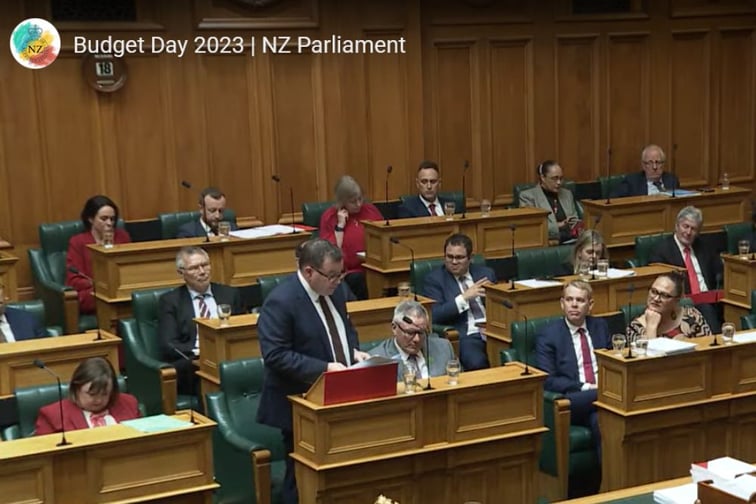

“It is hard to remember a time in New Zealand’s history where there have been so many challenges to our economic, environmental, and social systems in such a short period of time.”
Those were the words of Finance Minister Grant Robertson (as seen in the above screengrab from Parliament’s video recording) during Thursday’s Budget 2023, the goal of which was to strike “a careful balance” between supporting Kiwis with the cost-of-living, delivering core public services well, improving the resilience of New Zealand’s critical infrastructure and economy, and returning to a more sustainable fiscal position.
Among the key areas discussed by Robertson was recovery and resilience, under which an initial $6 billion investment was highlighted as part of a new National Resilience Plan. The aim is to address the country’s infrastructure deficit.
In his Budget speech, Robertson said: “The COVID-19 pandemic and recent extreme weather events earlier this year show just how important it is to improve our resilience as a country. Severe weather in the North Island at the start of the year caused widespread disruption and damage to people’s lives and properties, the scale of which will be felt for some time.
“In the immediate aftermath of the events, we made urgent investments to support the response, including direct financial support to businesses and growers, repairing damaged infrastructure, and providing temporary housing and other assistance to affected families. In advance of the Budget more than $800 million had been allocated to this emergency response work.
“We are building on our immediate response by investing a total of $941 million of operating and $195 million of capital in Budget 2023 to support the recovery and invest in regional resilience.”
According to the Minister of Finance, the package will help local government improve flood protection, invest a further $475 million to rebuild railways and roads, repair or rebuild damaged schools and whānau homes, and ensure the provision of temporary accommodation for those who were dislocated.
Robertson added: “The package also invests in the provision of health and mental wellbeing services, including the extension of Mana Ake. This package also maintains our support for those people made vulnerable by these events.
“This includes $11 million to top-up community support funds and reduce food insecurity, funding to help businesses retain staff and displaced workers find new employment quickly, and to help connect individuals and whānau to the support that they need.”
Meanwhile, with the primary sector and rural communities badly impacted by the recent weather events, Budget 2023 also continues its support for their recovery by way of an additional $30 million allocated for time-sensitive health & safety and animal welfare issues.
“This is all part of the ‘rolling maul’ of support for weather-affected regions,” Robertson said. “There is further work underway on regional and sectoral strategies and on support for severely affected properties.
“We are committed to a regionally-led recovery where local voices are central to government decisions. We are supporting regional recovery structures to coordinate recovery as well as the Cyclone Gabrielle Recovery Taskforce and local public service coordination for each affected region.”
A big part of the government’s recovery and resilience thrust is its focus on infrastructure.
Robertson said: “The government has taken significant steps to address New Zealand’s infrastructure deficit. We have committed $71 billion of infrastructure investment over the next five years in addition to the $45 billion we have spent on infrastructure in the past five years. This is the funding that builds our schools, hospitals, public housing, [and] rail and road networks.
“In the last term of government we set up the Infrastructure Commission/Te Waihanga, which developed the New Zealand Infrastructure Strategy, identifying the challenges New Zealand is facing over the next 30 years. We know we need to change how we think about infrastructure planning and resourcing.
“Alongside this Budget, we have released our Infrastructure Action Plan, which supports our response to the strategy and which is crucial to continuing to deliver the infrastructure transformation required while providing certainty to the construction sector.”
The Minister pointed to the need to future-proof the infrastructure in New Zealand for the country’s growing and changing population, climate change events, and to make use of the available developing technology.
“The North Island weather events added a level of urgency to our infrastructure investment planning and highlighted the importance of resilience in the face of climate change and increasing extreme weather events,” Robertson said.
“Today I am announcing a major change in how we address our infrastructure deficit and build a more resilient nation. Through Budget 2023 we are investing $6 billion in the initial phase of a National Resilience Plan. This will support medium- and long-term infrastructure investment and focus in the first instance on building back better from the recent weather events.”
According to the Minister, the initial focus of investments will likely be on road, rail, and local resilience. Additionally, telecommunications and electricity transmission investment is high on the agenda as well.
Robertson said: “As indicated at Budget 2022, the change to the fiscal rules means we can use our balance sheet more effectively to support long-term productive investments such as this programme.
“For too long governments have kicked the can down the road when it comes to investing in resilient and essential infrastructure investment. Today we embark on the long-term nation-building that I believe a responsible government must do.”
What do you think of Budget 2023? Share your thoughts in the comments below.
